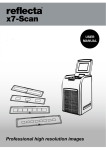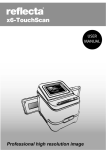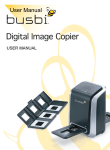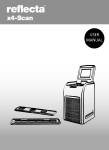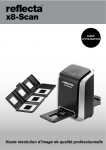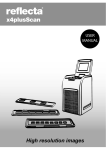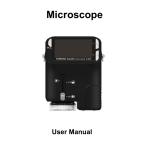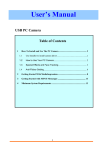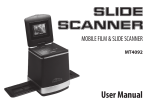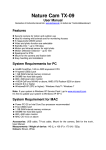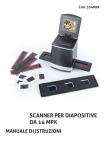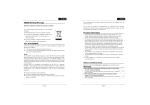Download User Manual - Kaiser Baas
Transcript
Photo Maker User Manual PhotoMaker Mac Manual.indd 1 12/01/2011 4:46:14 PM PhotoMaker Mac Manual.indd 2 12/01/2011 4:46:14 PM PhotoMaker Contents 1. Precautions 2 2. Standard Accessories 3 3. Part Names 4. Installing the software (PC) 4 5 5. Installing the software (MAC) 9 6. Placing film / slide in the holder 10 7. Connecting the PhotoMaker 11 8. Capturing photos (PC) 12 9. Capturing photos (MAC) 16 10. Editing photos 20 11. Specifications 28 12. Trouble Shooting 29 PhotoMaker Mac Manual.indd 3 User Manual PhotoMaker Pg 21 12/01/2011 4:46:14 PM PhotoMaker 1. Precautions Before using the PhotoMaker, please ensure that you read and understand the safety precautions described below. Always ensure that the PhotoMaker is operated correctly. 1. Do not try to open the case of the PhotoMaker or attempt to modify it in any way. Maintenance and repairs should be performed only by Kaiser Baas. 2. Keep the PhotoMaker away from water and other liquids. Do not use with wet hands. Moisture creates the danger of fire and electric shock. 3. If you notice smoke or a strange odour coming from the PhotoMaker, disconnect it immediately. Contact the Kaiser Baas Support Centre to organise repair. Never attempt to repair the PhotoMaker on your own. 4. PhotoMaker may become slightly warm during use. This does not indicate malfunction. 5. If the exterior of the PhotoMaker needs cleaning, wipe it with a soft, dry cloth. Pg 1 2 PhotoMaker PhotoMaker Mac Manual.indd 4 User Manual 12/01/2011 4:46:14 PM PhotoMaker 2. Standard Accessories 1x PhotoMaker 1 x Cleaning Brush 1 x Gloves 1 x Blow Air Brush PhotoMaker Mac Manual.indd 5 1 x Software CD 1 x Slide Holder 1 x Negative Holder 1 x Quick Start Guide User Manual PhotoMaker Pg 23 12/01/2011 4:46:15 PM PhotoMaker 3. Part Names Power LED USB Cable Film / Slide Holder Slot Brush Slide Holder Negative Holder Note: For clear images, we strongly suggest that you periodically clean the PhotoMaker by using the included cleaning brush. Insert the brush with the cleaning side down into the PhotoMaker slot to clean the glass surface. Please make sure your film negatives / mounted slides and cover trays are clean before inserting into the PhotoMaker. Dust or dirt from the negatives and cover trays will affect the quality of your scanned images. Pg 14 PhotoMaker PhotoMaker Mac Manual.indd 6 User Manual 12/01/2011 4:46:16 PM PhotoMaker 4. Installing the software (PC) Insert the provided CD into the CD/DVD ROM drive on your computer. The following screen should appear: 1. Select ‘MediaImpression’ to start the installation of Arcsoft MediaImpression on your computer. If the operating system asks for permission click ‘Yes’. 2. The Setup Language box will appear. The default is English. Choose your language then press ‘OK’. 3. The next screen informs you that InstallShield Wizard will install Arcsoft MediaImpression on your computer. Click ‘Next’. PhotoMaker Mac Manual.indd 7 User Manual PhotoMaker Pg 25 12/01/2011 4:46:16 PM PhotoMaker 4. The next screen shows the software licence agreement. If you agree to the terms and conditions and would like to keep installing the program click on ‘Yes’. 5. On the next screen, you are able to choose where you would like to install the program on your computer. If you are happy with the default, click ‘Next’. To choose a new destination click ‘Browse’, choose the folder you would like then click ‘Next’. Pg 1 6 PhotoMaker PhotoMaker Mac Manual.indd 8 User Manual 12/01/2011 4:46:16 PM PhotoMaker 6. The next screen lets you choose where you would like the program shortcut to appear in the Windows menu. Choose a destination or leave the default, then press ‘Next’. The program will then install to your preferred destination. 7. You can then choose what image file formats you would like to use in the program. Choose your preferred formats or leave the defaults, then click ‘Next’. PhotoMaker Mac Manual.indd 9 User Manual PhotoMaker Pg 2 7 12/01/2011 4:46:17 PM PhotoMaker 8. The software installation is now complete. Click ‘Finish’ and restart your computer to finalise the installation. 9. When the computer has rebooted, there should be an icon for MediaImpression on the desktop. Double click to start the program. Pg 1 8 PhotoMaker PhotoMaker Mac Manual.indd 10 User Manual 12/01/2011 4:46:17 PM PhotoMaker 5. Installing the software (MAC) 1. Insert the installation CD into your computer’s CD-ROM drive and click CD icon. 2. Click “MediaImpression Installer”. 3. Follow the on-screen instructions. PhotoMaker Mac Manual.indd 11 User Manual PhotoMaker Pg 2 9 12/01/2011 4:46:18 PM PhotoMaker 6. Placing film/slide into the holder 1. Place the negative film or slide holder in front of you with the Kaiser Baas logo facing upward. Open the negative film / slide holder as illustrated below. 2. Place your negative film strip / slides into holder as shown 3. Close the holder and make sure it clips closed properly. Pg 1 10 PhotoMaker PhotoMaker Mac Manual.indd 12 User Manual 12/01/2011 4:46:18 PM PhotoMaker 7. Connecting the PhotoMaker 1. Plug the USB cable of the PhotoMaker into an available USB 2.0 port on your computer. Once connected the power LED light on the PhotoMaker will illuminate. 2. Insert the loaded negative film / slide holder properly into the slot according to the triangular signs as shown. IMPORTANT: INSERTING HOLDERS INCORRECTLY MAY DAMAGE YOUR PHOTOMAKER Insert holder through the front entrance of the PhotoMaker PhotoMaker Mac Manual.indd 13 User Manual PhotoMaker Pg 2 11 12/01/2011 4:46:19 PM PhotoMaker 8. Capturing photos (PC) 1. Click on the MediaImpression icon on the desktop to start the application. 2. Click “Acquire” and select “Aquire from Film Scanner“ Pg 1 12 PhotoMaker PhotoMaker Mac Manual.indd 14 User Manual 12/01/2011 4:46:20 PM PhotoMaker 3. Define your save settings: a) Select between JPG or TIF image file formats. b) Choose from four quality levels: Highest / High / Normal / Low (for JPG format only). c) Select the location to save your images. PhotoMaker Mac Manual.indd 15 User Manual PhotoMaker Pg 2 13 12/01/2011 4:46:21 PM PhotoMaker d) Select flim size: 135. (110 Film holders can be purchased from Kaiser Baas. See website or contact Kaiser Baas for details.) e) Select the film type you are going to scan. Then choose colour depth and DPI. f) Click “OK”. Pg 1 14 PhotoMaker PhotoMaker Mac Manual.indd 16 User Manual 12/01/2011 4:46:22 PM PhotoMaker 4. Capturing images You will see the image to be captured in the live view window on your computer. Move the holder so that the image is correctly positioned and to avoid any dark edges caused by the edges of the holder. If dark edges appear on the top or bottom of the image tilt the PhotoMaker left or right to help position the slide correctly. Click “Capture” to save image to your computer. 5. Move the negative film / slide holder and press “Capture” for the next negative or slide to be captured. Repeat this step for the amount of negatives or slides you need to capture. Click “Exit” when you have finished. PhotoMaker Mac Manual.indd 17 User Manual PhotoMaker Pg 2 15 12/01/2011 4:46:22 PM PhotoMaker 9. Capturing photos (MAC) 1. Click on the MediaImpression icon on the desktop 2. Click “Acquire” then select “Aquire from Film Scanner “ Pg 1 16 PhotoMaker PhotoMaker Mac Manual.indd 18 User Manual 12/01/2011 4:46:23 PM PhotoMaker Define your save settings: a) Select between JPG or TIF image file formats. b) Choose from four quality levels: Highest / High / Normal / Low (for JPG format only). c) Select the location to save your images. PhotoMaker Mac Manual.indd 19 User Manual PhotoMaker Pg 2 17 12/01/2011 4:46:24 PM PhotoMaker d) Select flim size: 135. (110 Film holders can be purchased from Kaiser Baas. See website or contact Kaiser Baas for details.) e) Select the film type you are going to scan. Then choose colour depth and DPI. f) Click “OK”. Pg 1 18 PhotoMaker PhotoMaker Mac Manual.indd 20 User Manual 12/01/2011 4:46:25 PM PhotoMaker 3. Capturing images You will see the image to be captured in the live view window on your computer. Move the holder so that the image is correctly positioned and to avoid any dark edges caused by the edges of the holder. If dark edges appear on the top or bottom of the image tilt the PhotoMaker left or right to help position the slide correctly. Click “Capture” to save image to your computer. 4. Move the film holder and press “Capture” for the next film scan. PhotoMaker Mac Manual.indd 21 User Manual PhotoMaker Pg 2 19 12/01/2011 4:46:25 PM PhotoMaker 10. Editing pictures Photo Editing Tools The Photo Editing Tools module in Arcsoft MediaImpression includes a complete set of photo enhancement, editing and retouching controls. The windows can be stretched to provide a large size viewing area of the active photo. Double click the module’s tool bar to maximise the window to fill the computer screen. In addition to the large photo workspace, the Photo Editing Tools module includes two distinct sets of controls: 1. Adjust 1.1. Enhance The Enhance feature includes two types of controls: - Auto Enhance Click the “Auto Enhance” button to improve the overall quality of your pictures with a single click. - Manual Fix For precise image enhancement control, adjust the brightness, contrast and sharpen sliders. To enhance a photo manually: 1. Move the sliders to adjust the level of brightness, contrast, saturation, hue and sharpen. 2. Use the zoom slider to get a closer look at how the adjustment affects the photo. 3. Click “Apply” if you like the result. Click “Cancel” if you don’t. Pg 120 PhotoMaker PhotoMaker Mac Manual.indd 22 User Manual 12/01/2011 4:46:25 PM PhotoMaker 1.2. Colour This feature is designed to fix photos that have unnatural colour or appear too dark. It’s also great for fixing scanned versions of old prints that have faded or whose colours have changed after many years. To fix the colour of a photo: 1. Drag the colour balance sliders to make the photo colour appear more natural. Add red or yellow to make the photo warmer. Add blue or green to make the photo cooler. 2. Drag the Lighter/Darker slider to the left to reveal details hidden in a dark photo or to the right to make a faded photo look new again. 3. Click “Apply” if you like the result. Click “Cancel” if you do not. 1.3. Red-Eye This feature makes it easy for you to fix red-eye – a common problem in flash photography. There are two ways to fix red-eye: - Auto Fix 1. Simply click the “Fix Red-Eye” button to automatically find and fix all red-eye. 2. If not all of the red eye has been fixed, use the manual “Click to Fix” method. PhotoMaker Mac Manual.indd 23 User Manual PhotoMaker Pg 21 2 12/01/2011 4:46:26 PM PhotoMaker - Manual Fix 1. Use the zoom slider on the toolbar to zoom in on the photo. 2. Drag the small white box inside the zoom navigator to move over a red eye. 3. Place your cursor directly over the red eye and click. 4. Repeat the process until all the red eyes are fixed. 5. Click “Undo” if you make a mistake or don’t like the result. 1.4. Crop This feature enables you to trim photos for a dramatic effect or cut off the distracting parts of a picture. How to use the crop function: 1. Choose the crop orientation (portrait or landscape). 2. Select a fixed proportion for the crop rectangle (4:6, 5:7, 8:10) or choose “Custom” if you want to use a different proportion. 3. Resize the crop rectangle by clicking and dragging the red lines. 4. Move the crop rectangle into position by clicking and dragging inside the red box. 5. Click “Crop”. The area inside the rectangle will be kept, the area outside will be trimmed away. 6. Click “Undo” if you make a mistake or do not like the result. Pg 122 PhotoMaker PhotoMaker Mac Manual.indd 24 User Manual 12/01/2011 4:46:26 PM PhotoMaker 1.5. Straighten This feature enables you to fix photos that appear to be tilted. How to use Straighten: 1. Move the slider (or click the rotate buttons) until the photo appears straight. 2. Use the superimposed grid lines for vertical and horizontal reference. 3. Click “Apply” if you like the result. Click “Cancel” if you do not. 1.6. Blur Background This feature can be used in a subtle way to tone down un-important background details, or for dramatic effect by making the main subject of a photo “pop out” of the picture. How to use the Blur Background function: 1. With your cursor, trace a line around the person or object you want to stand out. When you release the mouse button, the area outside the traced line will become slightly blurred. 2. Drag the first slider to make the transition between the blurred and non-blurred area sharp or smooth. 3. Drag the second slider to increase or decrease the amount of blur. 4. Click “Apply” if you like the result. Click “Cancel” if you do not. PhotoMaker Mac Manual.indd 25 User Manual PhotoMaker Pg 2 23 12/01/2011 4:46:26 PM PhotoMaker 2. Retouch 2.1. Healing Brush The Healing Brush is good for fixing dust, scratches and removing skin blemishes. How to use the Healing Brush to fix a skin blemish: 1. Establish a source point for the Healing Brush by holding the Shift key and clicking on an area of the skin that is close in color and texture to the area you want to heal. 2. Use the zoom control to zoom in on the blemish. 3. Adjust the size of the healing brush so the cursor (circle) is only slightly larger than the blemish. 4. Paint over the blemish. The area will be concealed. 5. Click “Undo” if you make a mistake or do not like the result. 2.2. Lighten/Darken The Lighten/ Darken tool is good for adjusting specific areas of a photo. 2.3. Smudge Simulate the smearing of wet paint. Click and drag the sliders to change the brush size and sharpness. Pg 124 PhotoMaker PhotoMaker Mac Manual.indd 26 User Manual 12/01/2011 4:46:26 PM PhotoMaker 2.4. Clone The Clone tool is good for removing unwanted elements from a photo. It can also be used for a fun effect, like moving a nose from one person to another. How to use the Clone tool to remove a telephone pole from the background of a photo: 1. Establish a source point for the Clone tool by holding the Shift key and clicking on an area of the sky that you want to use to paint over the telephone pole. 2. Adjust the brush size so the cursor (circle) is only slightly larger than the widest part of the telephone pole. 3. Click and hold your mouse button and carefully paint over the telephone pole. Do not release the mouse button until the job is done. The sky will be cloned into place. 4. Click “Undo” if you make a mistake or do not like the result. 2.5. Sharpen Sharpen blurry areas. Click and drag the sliders below to change the brush size and transparency. 2.6. Blur Smooth out rough areas. Click and drag the sliders to change the brush size and intensity. PhotoMaker Mac Manual.indd 27 User Manual PhotoMaker Pg 25 2 12/01/2011 4:46:26 PM PhotoMaker 2.7. Paint Brush Allows you to “paint” on your image when you click and drag the mouse. Click and drag the sliders to change the brush size and transparency. 2.8. Line Draw a straight line in the photo. Click and drag the sliders to change the line width and transparency. 2.9. Eraser Simulate an eraser, removing the image painting by paintbrush and line tools from your photo. Click and drag the sliders to change the eraser size and effect. 3. Clipboard Clip the pictures by selecting Rectangular, Elliptical, Freehand, Magic wand and Magnetic. Note: For more detailed information, please refer to the ‘Help’ section of program. Pg 126 PhotoMaker PhotoMaker Mac Manual.indd 28 User Manual 12/01/2011 4:46:26 PM L PhotoMaker 11. Specifications Image Sensor Lens Specification Colour Balance 1/2.5” inch 5 mega CMOS sensor, 5.17 Megapixels F=6.4, f=12.36mm 2G2P Automatic Exposure Control Automatic Support Film size 135 Film (36mm x 24mm) 110 Film (17mm x 13mm) (optional) Support Film type Slide Colour Negative Film Black & White Negative Film Focus Range Fixed focus PC interface USB 2.0 Image Format Light Source Power Dimension Bundled Software 135 Film 3:2 ratio 110 Film 4:3 ratio (optional) 3 white LED From USB port, 104 (W) x 90 (L) x 166 (H) mm ArcSoft Medialmpression 2 Specifications are subject to change without prior notice. PhotoMaker Mac Manual.indd 29 User Manual PhotoMaker Pg 2 27 12/01/2011 4:46:26 PM PhotoMaker 12. System Requirements PC System Requirements • • • • • • • Pentium® P4 1.6GHz or equivalent AMD Athlon Free USB2.0 port 1GB RAM 500MB free hard disk space 1024 x 768 pixel colour monitor CD-ROM drive Windows® XP Service Pack II / Vista™, 32/64 bits Windows 7 Mac System Requirements • • • • • • • G5 or Intel Core Duo processor recommended Free USB2.0 port 1GB RAM 500MB free hard disk space 1024 x 768 colour monitor CD-ROM drive Mac 10.5 or above Pg 1 28 PhotoMaker PhotoMaker Mac Manual.indd 30 User Manual 12/01/2011 4:46:27 PM PhotoMaker 13. Trouble Shooting Issue Possible cause Resolution My computer does not recognise the PhotoMaker. PhotoMaker not plugged into a high-speed USB port. Your computer must have a USB 2.0 to communicate with your Photomaker. Check to see if USB 2.0 is installed on your computer. If you do not have a USB 2.0 installed on your computer you can upgrade your USB ports. This hardware is available at most computer stores. My installation disc will not auto start CD drive may not be set to autorun. May be a problem with install CD. May be a problem with your CD drive. On your PC choose My Computer and navigate to your CD Rom drive. Run the Menu application file. Check to see if your CD drive is operating properly. If possible check another computer to see if the disc is recognised. Some “Anti Virus” system may block the auto start, please install manually. My PhotoMaker works ok, but some of my slides or negatives look overexposed Time for auto exposure varies according to your computer configuration. The PhotoMaker self adjusts to your slide/negative exposure. Wait for the live view window to stop adjusting for exposure and then click “Capture” to get image. Check your slides or negatives to see if they may have been overexposed when originally developed. You may use the MediaImpression software to adjust or improve the image quality. My negatives are scanning as negatives and not full colour photo’s “Slide” has been selected rather than “negative”. Save location needs to be changed. Ensure that the right media is selected: Slide or Negative in the acquire images screen. Change the Save location in which the photos are saved in. I get a Windows message that reads “device not recognised” PhotoMaker Mac Manual.indd 31 User Manual PhotoMaker Pg 2 29 12/01/2011 4:46:27 PM PhotoMaker Issue Possible cause Resolution I found black edge in preview mode Slide might not be positioned in the holder correctly. Tilt the PhotoMaker left or right so the Slide shifts into the correct position in the Slide holder. Alternatively, remove the slide from the holder and re-insert. I found the black edge when seeing the photo Film/Slide size tolerance Crop the photo by software, detail user guide, please refer to this manual “Edit the picture” point “1.4 Crop” Your software will expire in XX days. You downloaded the similar trial software from ArcSoft website. Uninstall the downloaded MediaImpression and install the software again from the CD. My Mac computer does not work with the PhotoMaker. Your Mac. OS is version 10.4 or below. Some older Mac 10.4 version do not support the PhotoMaker. Please upgrade to its latest version 10.4.11 or above. Pg 1 30 PhotoMaker PhotoMaker Mac Manual.indd 32 User Manual 12/01/2011 4:46:27 PM PhotoMaker Mac Manual.indd 33 12/01/2011 4:46:27 PM 24/7 Tech support www.kaiserbaas.com/support PhotoMaker Mac Manual.indd 34 12/01/2011 4:46:27 PM




































